Creatures that have a cool ability that triggers when they enter the battlefield (ETB) can be found as far back in Magic: The Gathering‘s (MTG) history as Alliances, but Visions, released in 1997, was the first MTG set to truly lean into this area of card design.
Powerful spells like Unsummon and Terror were stapled to creatures like Man-o’-War and Nekrataal, creating efficient creature rates that made major waves at the time. Nowadays, we take this luxury for granted, and even look for ways to extract additional value from these types of cards in a variety of constructed formats, including Commander.
Enter the flicker deck (also known as blink).
What is a Flicker Deck?
A flicker (or blink) deck temporarily removes creatures from your battlefield (usually by exiling), then returns them to play in order to trigger effects that occur when they enter the battlefield. This strategy can also include other permanent types and/or abilities that trigger when a permanent leaves the battlefield.
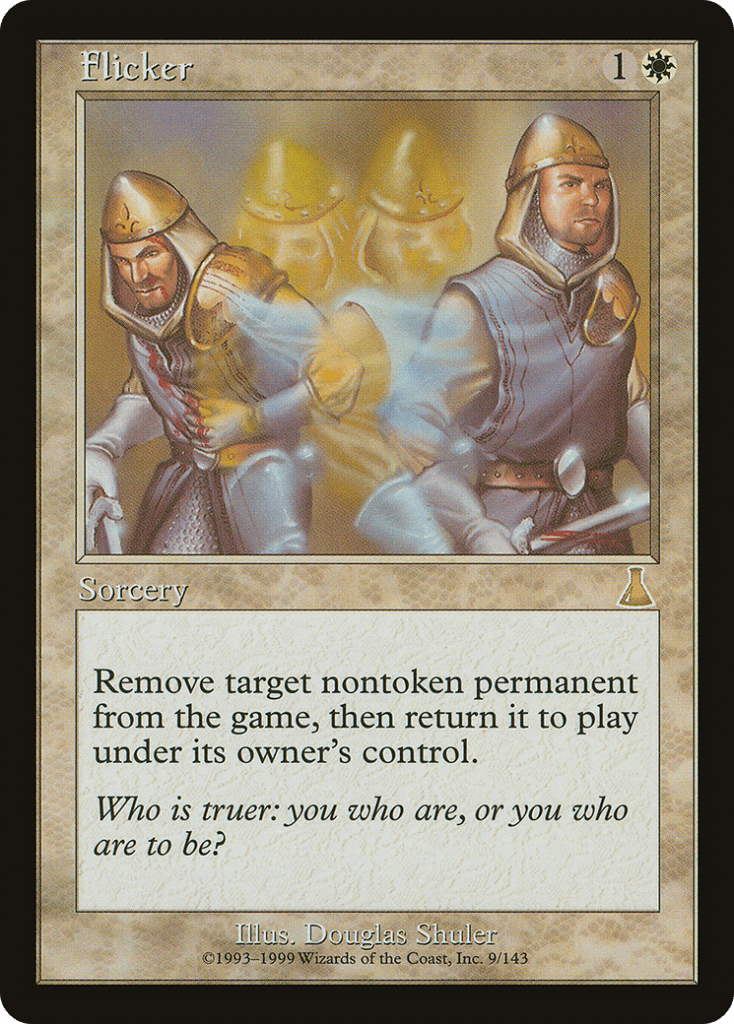
Named after cards like Ghostly Flicker and Momentary Blink (or Flicker and Blinking Spirit for veteran Magic players), a flicker deck focused on the actual aspect of flickering permanents in and out of play is generally focused on extracting a lot of value a little bit at a time from their cards. Commander decks are no different in this regard.
There are 2 traditional approaches to this style of gameplay. The first aims for an inexorable long game, carefully timing blink spells to safely reuse ETB effects, often countering single target removal or turning evenhanded board wipes into events where you come out far ahead of the rest of the table.
This style of flicker deck usually favors a commander who can enable flickering itself, and you can review my selection of the best commanders for enabling flicker decks if that is your preferred style of gameplay.
The second common method for building a flicker deck is choosing a commander that has a payoff that is so worthwhile, it is worth having access to at all times. You can still collect this payoff incrementally by adding extra value to your flicker effects, or you can aim for a combo strategy that goes infinite and ends the game with your victory when executed correctly.
Sometimes, you’ll even do both!
To find the very best options for this style of flicker deck, we’ll need to start by reviewing what good flicker payoff commanders have in common.
Traits of Good Flicker Commanders
A commander that delivers a good flicker payoff is going to have a lot in common with a commander focused on enabling flicker-based shenanigans. White and/or blue are musts for color identity, with access to both colors being preferred, and the lower the mana cost of your commander, the better, as it will be easier to cast.
In addition to these basic traits, however, it’s also important that our payoff require as few hoops as possible for us to jump through. While it isn’t strictly difficult to put a big creature into play, support several smaller creatures, or load up a graveyard, there are actually enough available flicker commanders that deliver easier payoffs that we don’t actually have to do any of these things!


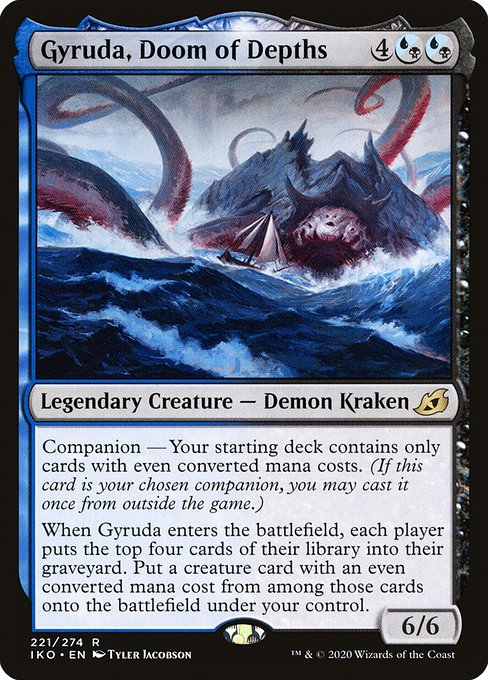

Figuring this out actually made narrowing a list of 29 possible candidates for this article down a lot easier. Fortunately, that also means that if none of the cards I talk about today speaks to you when building your flicker deck, there are lots of other great options in the MTG card pool to choose from!
Finally, the payoff from using a blink spell or blinking your commander needs to be really, really good. If it isn’t game winning, it better be bringing you some serious advantages or leverage over your opponents.
So to recap, your flicker payoff commander needs to have:
- Access to white or blue in its color identity (ideally both)
- A mana cost that is as low as possible, ideally not exceeding 6 mana
- Minimal or zero setup for collecting our flicker effects’ payoff
- An effect that creates the best possible payoff when using our flicker spells
Ready to see which commanders have the payoffs best suited to lead your flicker deck to victory? Presented in no particular power level order, let’s take a look!
Naru Meha, Master Wizard and Inalla, Archmage Ritualist
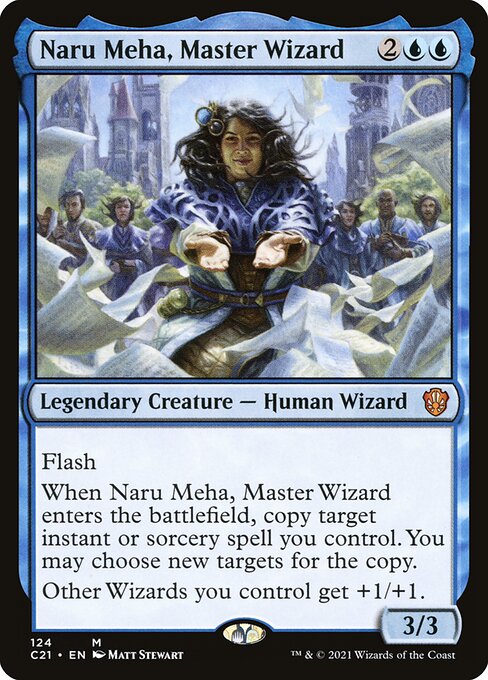

Naru Meha, Master Wizard and Inalla, Archmage Ritualist are effectively the same flicker combo deck built two different ways.
A deck with Naru Meha at the helm is going to be a little more restricted in how it goes off, relying primarily on flicker cards that can hit 2 targets like Ghostly Flicker and Displace as a combo piece.
From there, you can pair these flicker effects with cards like Peregrine Drake, Palinchron, or a basic land (in the case of Ghostly Flicker) for infinite mana, Overwhelmed Apprentice to mill your opponents out, or Venser, Shaper Savant to return all opposing permanents to their owners’ hands, just to name a few of the possibilities.
If you don’t want to go through the trouble of casting Naru Meha as part of your setup, you can also set up a combo with Ghostly Flicker, Archaeomancer, and Peregrine Drake to make infinite mana, then set up to Braingeyser your opponents or draw your deck and combo with Thassa’s Oracle as you see fit.
Inalla decks can be considerably more flexible when it comes to choosing their combos, as access to black opens up access to many more powerful tutors, and access to red brings Dualcaster Mage into the mix, which when combined with Inalla’s Eminence ability does a great Naru Meha impression for 1 less mana.
Eminence also works straight from the command zone, meaning you don’t need to have Inalla in play to use them to combo off. You can also create some lines of play with infinite Dualcaster Mage, Archaeomancer, or Izzet Chronarch tokens that have haste for an attacker-based victory, or simply cast Inalla after you’re done making tokens then ping your opponents to death 7 life at a time.
For those who want to practice the execution of these infinite loops, Aetherhub has you covered with some well laid out guides for what I’ve discussed, plus some others that are available for those building or learning Inalla, Archmage Ritualist combo decks.
Lavinia of the Tenth

Dragon’s Maze doesn’t have a good reputation, and there are several reasons for this. A couple of the most noteworthy include the problem of trying to cram support for 10 guilds into one small MTG set and the perceived pullback in power level, especially when compared to Return to Ravnica and Gatecrash.
Add in the fact that Wizards of the Coast also crammed in some new mechanical designs, and you’ve got a MTG set that really pleased nobody.
That said, there are some real gems within the set for Commander, and included among them is Lavinia of the Tenth. Once Lavinia enters the battlefield, she detains all nonland permanents your opponents control with a mana value of 4 or less, blocking your opponents from using their mana rocks, mana dorks, planeswalkers, and early creatures.
And you can easily set yourself up to do this again and again. Every. Single. Turn.
Conjurer’s Closet and Thassa, Deep-Dwelling will be some of the easiest ways to guarantee Lavinia keeps cheap permanents on lockdown, but having a suite of blink spells to back them up is never going to be a bad thing – especially since it won’t take long for Lavinia to become a priority removal target for the rest of the table.
Protection from red isn’t nothing either – being able to ignore board wipes like Blasphemous Act and Structural Assault is extremely handy, and the ability to hold off a bigger red creature later in the game like Etali, Primal Storm or Inferno Titan can save you from a lot of unwanted damage in certain matchups.
If you’re trying to get around Lavinia’s shenanigans, your best bet is to lean more on triggered abilities from your permanents. Cards like Opposition Agent, Deep Gnome Terramancer, and Rhystic Study work just fine while being detained, giving you time to access more expensive spells that Lavinia’s influence cannot reach.
Ephara, God of the Polis
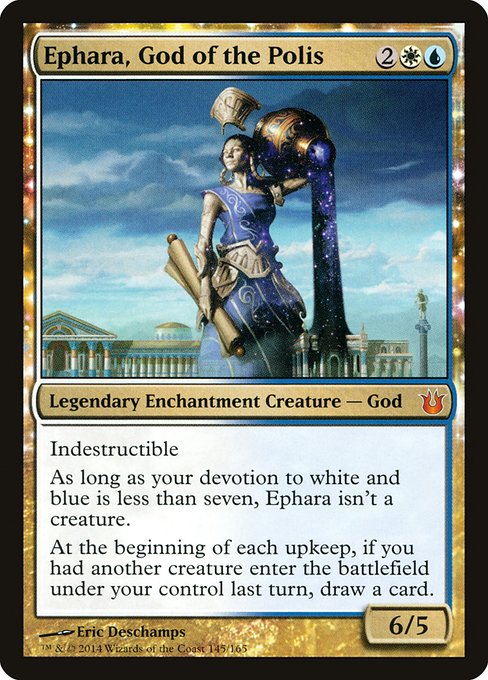
If Lavinia’s playstyle is a little too aggressive for your taste, Ephara, God of the Polis offers Azorius players a much more subtle approach to accruing value from your flicker spells.
The trick to Ephara’s card draw engine is that it triggers on every upkeep, not just your own. This means if you flashed in a creature on an opponent’s turn, dodged a removal spell with Ephemerate, or simply played a new creature on your turn, you’re drawing a card during the next upkeep.
As you draw more cards, you’ll draw more ways to take advantage of Ephara’s ability, which in turn keeps a steady flow of new cards coming to your hand. Add in that Ephara is indestructible, and it becomes very difficult to stop this deck once it really gets going.
Especially if you’re also picking up additional ETB triggers from the creatures you’re playing and flickering.
Feather, the Redeemed

Feather, the Redeemed lends itself to a very specific style of deckbuilding, and white’s pool of flicker effects has a lot of overlap with it. Like Ephara, God of the Polis, a flicker deck centered around Feather is going to be focused on incremental value, but rather than drawing lots of new cards, you’re going to be using the same handful as many times as possible.
This gets especially silly if your flicker spells also have additional upside stapled to them. Acrobatic Maneuver and Settle Beyond Reality are some of the best examples of this, but even something as minor as adding a +1/+1 counter through Otherworldly Journey can come in handy when spread across several creatures.
Feather’s ability is also useful if you’re casting an instant or sorcery that has a different replacement effect that kicks in when it would normally try to go to the graveyard, such as being exiled by Dreadhorde Arcanist or Past in Flames.
In these cases, you can simply choose to apply Feather’s replacement effect instead, turning your graveyard, Rebound spells like Ephemerate, and abilities that operate similarly to Rebound like Jump-start into very abusable resources that you can use to protect and flicker your creatures ad nauseam.
Pramikon, Sky Rampart

Pramikon, Sky Rampart is a commander I’ve been trying to figure out how to build around since it came out in Commander 2019, and I may have finally found part of my answer. The idea of simplifying multiplayer combat is very attractive, but comes with a number of problems if someone outside of your reach becomes a major threat.
Blinking Pramikon so that you can easily shift the direction of attacks provides a good way to address some of the hazards Pramikon normally brings to table politics while also opening up the ability for attacks to proceed unimpeded when casting a flicker effect that returns your creature to play at the end of a turn, adding considerable flexibility to a very inflexible effect.
This flexibility also carries over to deck construction, opening up access to a lot of potential builds since your flicker spells will primarily be reserved for your commander, meaning you don’t have to build around a lot of ETB effects to take advantage of Pramikon’s payoff.
You still can of course, but planeswalkers, Stax, and decks with win conditions that thrive simply by biding their time (Darksteel Reactor and Azor’s Elocutors anyone?) are also very viable options here.
And if the board becomes a little too overpopulated with creatures, you can also shut attacks off outright by pairing Pramikon with Mystic Barrier, Spark Double, or Sakashima of a Thousand Faces if need be. Your pod might not appreciate this, but in the event of double Pramikons, there will at least be plenty of pretty colors to distract them from their annoyance.
Derevi, Empyrial Tactician

While Derevi, Empyrial Tactician is best known in cEDH circles for its Stax builds (and as someone who has had their resources completely choked out multiple times this way, its reputation is well deserved), the ability to tap or untap a permanent when it enters the battlefield also offers a lot of opportunities for abuse.
Derevi’s primary partner in crime for mass blinking is Deadeye Navigator. Repeatedly untapping cards that tap for 3+ mana like Faeburrow Elder, Bloom Tender, or Lotus Field makes infinite mana on the spot, and with green’s ample access to creature tutors and Derevi’s insulation against commander tax, assembling these combos is not difficult at all.
From there, you can easily funnel that mana into an overwhelming battlefield through Genesis Wave, make everyone draw their deck with Blue Sun’s Zenith, or just keep everyone’s permanents tapped down during their upkeep until you find a different way to win.
Infinite combos and Stax are far from the only ways to make a Derevi flicker deck dangerous, however. In addition to the traditional value plays open to conventional ETB repetition, Wizard tribal builds can also bring a lot to the table.
Cards like Azami, Lady of Scrolls, Naban, Dean of Iteration, and the aforementioned Naru Meha, Master Wizard are just a few examples that synergize very well with Derevi’s talents, each setting you up to quickly race far ahead of your opponents in different ways.
Merieke Ri Berit

If you’re a control player, it’s very likely you enjoy having access to the coolest creatures on the battlefield – even if they don’t belong to you. Perhaps especially if they don’t belong to you. If you’re looking for a blink commander that scratches this itch and you haven’t been acquainted with Merieke Ri Berit, you’re in for a treat.
For the low, low price of tapping her, she gives you control of any creature on the battlefield. Definitely a powerful ability, and one that’s worth supporting with cards that grant or emulate haste like Lightning Greaves, Thousand-Year Elixir, or Swiftfoot Boots.
Unfortunately, Merieke stays tapped from this point onward, so if you want to discard the creature you’ve stolen in favor of another, you’ll normally have to find a way to kill her off first. Not easy outside of a board wipe, and that method defeats the purpose of taking the best creature on the battlefield in the first place.
Reading her effect more closely, however, Merieke doesn’t actually have to die – she merely needs to leave the battlefield or untap to destroy her stolen target. A flicker effect will not only do that, but bring her back untapped so she can steal something else!
This destruction clause is also a solid hedge against traditional answers to stealing creatures like Homeward Path, as returning your stolen creature or having it stolen from you by someone else doesn’t exempt it from being destroyed when Merieke leaves play.
Sadly, removing Merieke from the battlefield returns the creature to its owner (if it’s under your control) before it is destroyed, so you won’t be able to take advantage of any death triggers this way. On the bright side, untapping Merieke with an effect like Magewright’s Stone will get this job done without any issue.
Plus, if the creature you stole has indestructible when you untap her, you’ll still get to keep it for as long as Merieke is still in play while stealing something else!
General Tazri

As a diehard fan of Slivers when Allies debuted in Zendikar, the only thing I really liked about them was that they looked at your creatures rather than all creatures in play that shared the creature type. Otherwise, the idea seemed watered down, and I wasn’t sold.
The introduction of the Cohort mechanic in Oath of the Gatewatch to allies several years later didn’t do much to improve my opinion. I now have to tap 2 creatures I control to receive a comparatively small benefit?
Pass.
After taking the time to sit down and really see what Allies bring to the table now, I can admit I wasn’t fair to the concept. Except for Cohort. That mechanic is not good, nor is it ever likely to be.
From their inception over a decade ago, Ally creatures really leaned into effects that trigger when either that Ally creature or another Ally enters the battlefield. While there is definitely some mechanical overlap with Slivers in this capacity, Allies really made it a centerpiece of their identity, whereas Slivers generally focus on static benefits that affect all Slivers.
Naturally, this makes blink effects very effective in an Ally deck, especially once you factor in that an Ally trigger usually affects either all creatures you control or scales based on the number of Allies you already control. This takes the idea of incremental value – an already powerful force in a flicker deck – and turns it into something truly backbreaking.
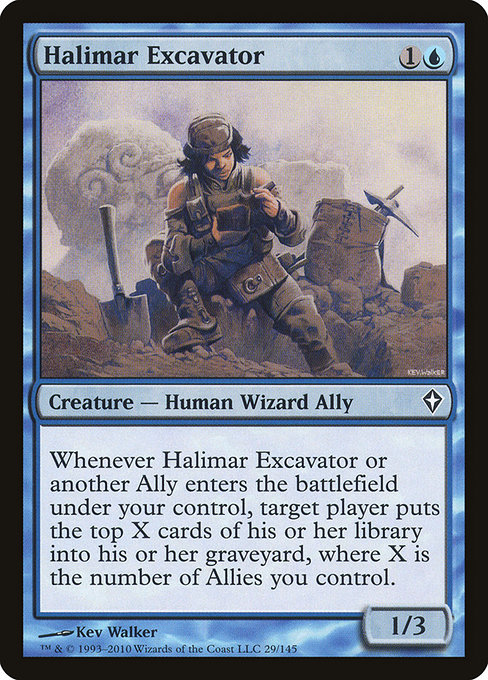



While a strong concept in theory, it took until General Tazri‘s release in Oath of the Gatewatch to really bring the Ally deck together in Commander. A tutor effect and win condition packaged together for the Ally tribe in an accessible creature with a 5-color identity was just what the deck needed to show what it was truly capable of.
Now if you need to find a specific Ally to start blinking repeatedly, you can simply blink Tazri and suddenly it’s in your hand. If you need to push a little further before pumping your team and swinging for victory, you can now hit the team with Ghostway or Eerie Interlude and watch the ETB triggers start rolling in.
The underappreciation for Allies also really works in their favor in a lot of Commander pods. Their ability to scale makes it quite easy to set up a very fast, yet subtle clock that is capable of pressuring and/or overwhelming the table a few different ways.
Add in a few flicker effects to reuse your best ETB triggers once you get going, and your opponents won’t know what hit them until it’s too late.
Reaper King

One of the original boogeymen of EDH before the format was renamed to Commander, the only thing that kept Reaper King from being an extremely toxic tribal build was the fact that there weren’t that many Scarecrows in Magic back then, and most that were in print were fairly mediocre.

That said, stapling a Vindicate to every single Scarecrow that enters the battlefield has always been impactful enough to overlook a typical Scarecrow creature’s mediocrity. While you usually needed a kicked Rite of Replication to close a game back in the day, there are so many more Scarecrows and Changelings available now that the quality of a Reaper King deck’s creatures has become appreciably higher in recent years.
Especially now that Painter’s Servant is unbanned and clones that skirt around the legend rule like Spark Double and Sakashima of a Thousand Faces have become a more popular design space to explore.
Since Reaper King is what turns Scarecrows into spot removal spells for any problem in play, it goes without saying that protecting it at all costs is critical once you’re able to safely play it. Once in play, however, you can simply go about playing the game as normal, saving your flicker spells to protect your commander and occasionally flickering other Scarecrows to clear problematic threats.
And if a well timed Ghostway doesn’t lead you to victory, Painter’s Servant and Grindstone is a perfectly valid, on-theme backup plan for closing out the game.
Garth One-Eye
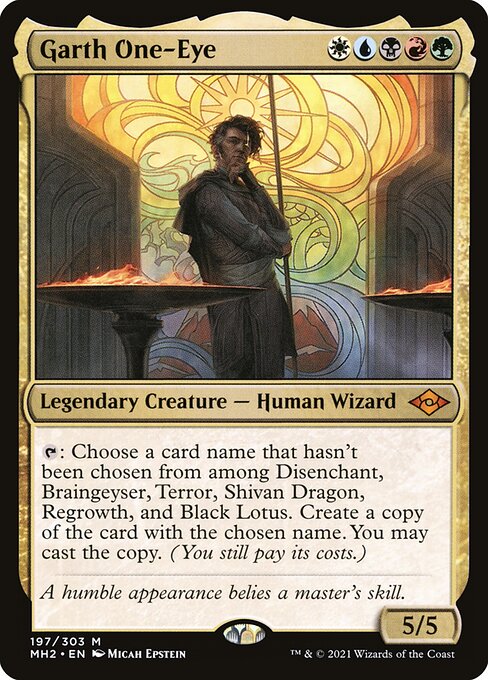
Garth One-Eye is a very interesting commander, even if you aren’t specifically building around a flicker theme. Access to 6 of MTG’s most iconic spells is incredibly powerful, and while only Braingeyser and Regrowth see consistent play in the format (though Black Lotus absolutely would if it was legal), Terror, Disenchant, and Shivan Dragon can all still be very handy.
As with many commanders that need to tap to activate their effects, finding ways to give Garth haste will be incredibly important. Access to all 5 colors makes this considerably easier, however, and effects that give all your creatures haste like Fervor are able to really shine when you’re setting Garth up for combos, as you can make infinite Shivan Dragons with a little preparation.
Jeskai Ascendancy and Deadeye Navigator are both great options for preparing your battlefield for a horde of dragons. The former requires a mass haste enabler and a 1 mana value flicker spell like Cloudshift or Essence Flux, letting you cycle through your deck as you continually use Garth’s Black Lotus and Regrowth effects to play your flicker spell.
As you dig through your deck, you’re looking for creatures that tap for mana, but only cost 1 mana to play, allowing you to start generating mana on each blink and Regrowth cycle. Braingeyser will let you refill your hand as needed at this point, and you should be able to generate infinite mana, infinite Shivan Dragons, or the opportunity to fire off infinite Braingeysers at your opponents.
RNR_Gaming has an excellent primer for this combo on Tapped Out, and it’s well worth the read if you’re looking for some practice before bringing this deck to your next Commander night.
Deadeye Navigator‘s approach is much simpler, as it generates infinite mana with a haste enabler and Garth’s Black Lotus effect. From there, you can destroy most nonland permanents or go infinite with Braingeyser and Shivan Dragon as desired.
How to Win with a Flicker Deck
Flicker decks that revolve around taking advantage of a commander’s payoff are going to dictate their primary win condition to you based on their effect. Some, like Merieke Ri Berit or Feather, the Redeemed, follow the same path as a flicker enabler like Aminatou the Fateshifter, looking to accumulate enough incremental value that it buries the rest of the table over time.
Many others are going to focus on collecting the pieces to execute an infinite combo. Garth One-Eye, Inalla, Archmage Ritualist, and Derevi, Empyrial Tactician are all great examples of commanders who enable this style of gameplay.
Still others aim to slow down the game until they can seize control of it on their terms. Lavinia of the Tenth and Pramikon, Sky Rampart are excellent commander alternatives to Brago, King Eternal if you are looking to supplement or avoid a traditional Stax deck.
No matter which of these routes to victory you aim for, timing and patience are critical for winning with a flicker deck. Being too aggressive with your flicker effects can leave you unable to defend your creatures or combos from removal spells, but being overcautious can also give your opponents time to draw the card they need to take control of the game.
If you’re looking to get better at mastering these two concepts, the best advice I can offer is to play some games of Commander! There’s no substitute for consistent practice in a game as complex as MTG, and this is especially true for combo decks, whose lines of play are so intricate a single misstep can mess up an entire combo.
Once you become familiar with the ins and outs of a flicker deck, however, there’s no better feeling than watching removal spells and other targeted effects fail to reach their mark as you assemble the cards to secure your victory.
Other MTG Articles You Might Enjoy
- MTG’s Best Flicker Commanders (Enablers)
- Best MTG Token Commanders
- Best White Ramp Spells in Commander
- MTG’s Best Black Tutor Cards for Commander
- MTG’s Best Blue Tutor Cards for Commander
- Top MTG EDH Reanimator Commanders
Braden is a founder of Assorted Meeples and has been a gamer & writer with a vivid imagination all his life. Don’t believe us? Check out his excitement when meeting Goosebumps author R.L. Stine as a kid! An avid Magic: The Gathering spellslinger for over 15 years, you can always convince him to shuffle up for a game (or three!) of Commander.
